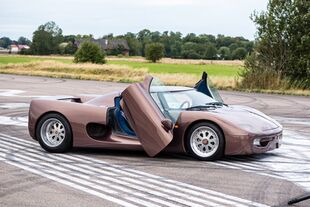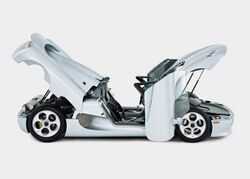Engineering:Koenigsegg CC
| Koenigsegg CC | |
|---|---|
 | |
| Overview | |
| Manufacturer | Koenigsegg Automotive AB |
| Production | 1994–2000 (3 working prototypes produced)[1] |
| Assembly | Ängelholm, Sweden |
| Designer | Christian von Koenigsegg David Crafoord[2] |
| Body and chassis | |
| Class | Sports car/ Concept car |
| Body style | 2-door Targa top |
| Layout | Rear mid-engine, rear-wheel-drive |
| Doors | Dihedral Synchro-Helix |
| Related | Koenigsegg CC8S |
| Powertrain | |
| Engine | 4.6 L Ford V8 supercharged[3] |
| Transmission | 6-speed manual[3] |
The Koenigsegg CC was the prototype for the CC8S sports car made by the Swedish automobile manufacturer Koenigsegg.
Overview
Work on the car started in 1994. Koenigsegg wanted to build a sports car that could exceed the standards set by the McLaren F1 at the time, and achieve speeds over the 386 km/h (240 mph) set by the F1 in 1997. The design of the CC was inspired by the McLaren F1 along with the Ferrari F40. The car, initially painted silver, was then painted black when the new dihedral helix synchro actuation doors were fitted, and finally was painted its current colour. Other two prototypes included the white European spec prototype which was produced in 2000 and the other was a pre-production version of the CC8S. The production version of the CC, the CC8S, was designed in 2002, and was the first car Koenigsegg produced.[4]
The deal with Audi for the use of their 4.2 V8 did fall flat after the car's designer, Christian von Koenigsegg, made clear his intent of tuning the V8 far beyond its standard output. The next candidate was the Flat-12 race engine developed by Motori Moderni for the Scuderia Coloni Formula One team, in which this engine was raced under the Subaru badge in the 1990 season. These Subaru 1235 engines were purchased and modified for use in the CC. This deal failed to materialise when the founder of Motori Moderni died, sending the company into bankruptcy.[5][6] Following a deal was made with Ford for use of the Modular V8.
References
- ↑ "Koenigsegg CC prototypes". KoenigseggRegistry.net. http://mobile.koenigsegg-registry.net/overview.shtml. Retrieved 2018-01-08.
- ↑ "The Italian Junkyard: 20.1 Sweden Ain’t That Cold: Christian Von Koenigsegg gives us a quick interview on how he made his dream come true". theitalianjunkyard.blogspot.se. http://theitalianjunkyard.blogspot.se/2011/03/sweden-aint-that-cold-christian-von.html.
- ↑ 3.0 3.1 "CC prototype". Koenigsegg. https://www.koenigsegg.com/cc-prototype/. Retrieved 2018-01-08.
- ↑ "CC prototype, history". Koenigsegg. https://www.koenigsegg.com/cc-prototype/. Retrieved 2018-01-08.
- ↑ "AMA1 With CvK - Early Years and Process". 10 August 2015. https://www.koenigsegg.com/ama1-with-cvk-early-years-and-process/. Retrieved 1 July 2019.
- ↑ DRIVETRIBE (2019-06-26), How Koenigsegg nearly used a Subaru F1 engine in its supercars, https://www.youtube.com/watch?v=tM_-u209ybs, retrieved 2019-06-27
External links
- www.koenigsegg.se – Koenigsegg site
- Koenigsegg CC specifications
 |


